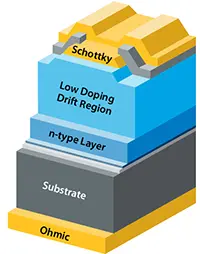About APEX
APEX understands that next-generation power conversion technologies will be the backbone of a highly electrified energy system, having the potential to significantly improve energy efficiency and address global energy consumption.
The mission of APEX follows from three key premises:
- Power electronics will be at the heart of U.S. infrastructure in 2050.
- Materials and manufacturing are at the heart of power electronics.
- Basic materials science and transformative manufacturing are needed today to meet the infrastructure challenges of the future.
In response, APEX will:
- Create foundational interface science for integrating active layers, contacts, substrates, and heat sinks in a way that delivers, rather than limits, new functionality
- Incorporate transformative manufacturing research to pave the way for scalability for next-generation materials and devices
- Look beyond existing roadmaps for power electronics materials integration and advance basic science to anticipate 2050 energy system and electrification goals.
Materials and Interface Needs

1. Stable contacts at elevated temperatures
2. High-performance active materials with low defect concentrations
3. New levels of heat management requiring enhanced thermal transport
4. Large area, lattice-matched/low-defect, conducting substrates
5. High-speed, lower-cost manufacturing
Knowledge Gaps
First-principle understanding of interface formation and evolutions between dissimilar materials
Synthesis of UWBG semiconductors of novel substrates
Kinetic control of bulk conductive ceramic substrate growth and defect formation
HVPE growth kinetics for sharp interfaces
Design principles for enhanced thermal transport at interfaces
Design principles for interface functionality and resilience
APEX Focus Areas
Predictions of interface structure; interlayer design for stability
Synthesis and integration of next-gen substrates and active layers
Science of electron and phonon transport at highly dissimilar interfaces
Correlative interface characterization; AI.ML for understanding defect formation and evolution
Advancing HVPE for scalable manufacturing and heterointerface formation
APEX will address these questions:
- What are the guiding principles that we can exploit to design interfaces that enable heterostructure formation with two desired but distinct materials?
- Can boride and carbide substrates be designed to facilitate growth of high-quality nitride device layers while enabling new vertical device architectures?
- How can we manipulate growth processes in manufacturing-relevant fabrication methods to synthesize more resilient interfaces and heterostructures identified through computation?
- How do the properties of the interfaces and heterostructures we can design and realistically synthesize impact mechanisms that are relevant for device performance and degradation?
To answer these questions, APEX's interdisciplinary team of scientists is inspired by the greatest energy challenge of our time: the need to rapidly innovate our way to a highly electrified ecosystem.
Share
Last Updated July 2, 2025
